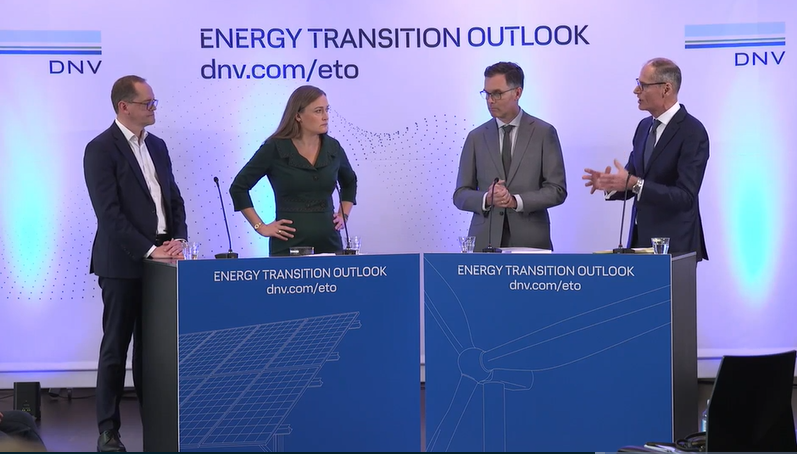Denmark could serve as a model for the rest of Europe in terms of decarbonization in the energy transition.
Still, one of the greatest barriers to net zero, claimed DNV’s CEO of energy systems Ditlev Engel, is not a lack of suitable technology but a lack of understanding of how to use it.
Speaking on a panel at DNV’s recent Energy Transition Outlook 2022 presentation, Engel was joined by Danish energy executives who explained the different roles their establishments are taking to help implement strategic renewable energy plans and lowering emissions. Despite already making considerable headway regarding the energy transition in Denmark, the panelists agreed—more action is needed on a larger scale in Europe.
Singular heads of state across Europe won’t create the policies needed to implement and activate energy transition technology, Danish Council on Climate Change chairman Peter Møllgaard said, so broader motions are required to make any real change.
“We’ve known that we have a problem [since 1988] and we haven’t acted as a planet,” Møllgaard said. “That’s part of the solution, but I also think we need something at the U.N. level to guide the entire world. We need also more action in the European Union.”
Speeding up the decision-making process is vital to getting the right legislation passed, he added, noting that while companies are usually more effective in implementing policies quickly than politicians, it is possible for governments to act with a sense of urgency.
“We managed as a globe to act rather quickly in the COVID pandemic,” he added. “We could use some of that decision-making power also for the green transition, to put it politely.”
The Danish Climate Act passed in 2020 established the role of climate chancellors to advise in governmental climate policy, engage in public climate debate and hold policymakers and companies accountable in a “watch dog” role. It also allows for the development and distribution of offshore wind through energy islands.

Ørsted’s offshore wind journey
Headquartered in Denmark, Ørsted sees itself as a “catalyst for the industry” when it comes to the energy transition, according to COO and deputy CEO Martin Neubert speaking on the panel.
While Ørsted thought it would take three decades to transition into the renewable space, Neubert said the company achieved it in only one.
“Offshore wind was described in 2010, 11, 12 as probably most expensive, unrealistic experiment in the North Sea, and see where we are today,” he said.
In 2008, the company decided to make a shift from producing 85% conventional power and 15% renewable power to focus more on developing renewable power.
Neubert added that he hoped the company’s success story would offer inspiration to the rest of the energy sector and the world, as it would show that it is possible to place a greater emphasis on renewables in a relatively short period.
“When you just sort of see any scenario looked at in the beginning of the year, what will happen to Europe and how will we do without Russian gas—which is the reality today—no one will have sort of predicted that we actually can continue and the lights will not go off,” he said. “I know we are in a crisis situation, but I think we have always underestimated what we can do if we pull our strengths together.”
Energinet’s ‘energy island’ strategy
Denmark will also become the first country in the world to create energy islands, which the government believes will be essential to spreading renewable wind power across the globe.
With energy islands, engineers can create a “nearshore environment” composed of platforms to connect offshore wind farms with nearby countries with shorter seabed cables, which can then be used to transport the renewable energy to the countries.
Hanne Storm Edlefsen, vice president of energy islands at Energinet who also spoke on the panel, explained that energy islands are a way to share the benefits of renewable power with those who don’t readily have access.
“We need way more energy renewable, and we need to share it because not everybody has these faster amounts of wind resources close to them,” Edlefsen said. “We also need to connect because then we can connect across consumption and production patterns.”
In the short term, the wind farms will be able to provide 3 GW-4 GW of renewable energy, but Energinet anticipate being able to implement up to 10 GW in the future.
“The key is that no man is an island. We need to stand together, and we need to develop these things together in the sector,” she continued. “You can be quite paralyzed about the complexity of these huge projects, but the point is that we need to be bold.”
Recommended Reading
Oceaneering Won $200MM in Manufactured Products Contracts in Q4 2023
2024-02-05 - The revenues from Oceaneering International’s manufactured products contracts range in value from less than $10 million to greater than $100 million.
E&P Highlights: Feb. 5, 2024
2024-02-05 - Here’s a roundup of the latest E&P headlines, including an update on Enauta’s Atlanta Phase 1 project.
CNOOC’s Suizhong 36-1/Luda 5-2 Starts Production Offshore China
2024-02-05 - CNOOC plans 118 development wells in the shallow water project in the Bohai Sea — the largest secondary development and adjustment project offshore China.
TotalEnergies Starts Production at Akpo West Offshore Nigeria
2024-02-07 - Subsea tieback expected to add 14,000 bbl/d of condensate by mid-year, and up to 4 MMcm/d of gas by 2028.
US Drillers Add Oil, Gas Rigs for Third Time in Four Weeks
2024-02-09 - Despite this week's rig increase, Baker Hughes said the total count was still down 138 rigs, or 18%, below this time last year.




